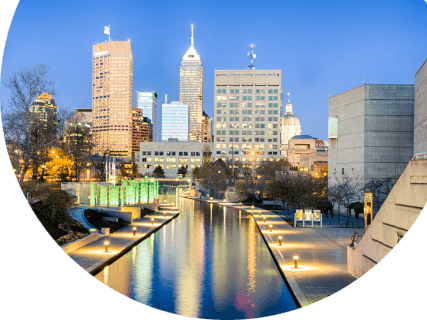Indianapolis is the state capital of Indiana with a total population of 2 million including the metropolitan area. It is Indiana's largest city and is the thirteenth largest city in the US.
Today, Indianapolis has a diversified economy. Tourism is a vital part of the Indianapolis economy and the city plays host to numerous conventions and sporting events. Indianapolis is known as the "Racing Capital of the World", the "Amateur Sports Capital of America" for hosting the NCAA and has many attractions including museums, ethnic restaurants, arts and historic districts including a culturally diverse down-town.
History
The native American Miami and Lenape tribes had been removed prior to the city’s founding in 1821. Named after Indiana (the state) and polis (the Greek for city), Indianapolis’s early history centred around manufacturing. The expectation of the founders that Indianapolis would be the "Great Inland Port" were dashed as the White River sandbars make navigation impossible year round.
The original Indianapolis city plan was just one square mile (3 km²) with the Governor’s mansion at the center. The governor's mansion was demolished in 1857 and replaced by the Indiana Soldiers' and Sailors' Monument.
The first rail-road to service Indianapolis in 1847 created growth and Indianapolis became a large automobile manufacturer and a major hub connecting to Chicago, Louisville, Cincinnati, Columbus, Detroit, Cleveland and St. Louis, from where came Indiana state’s nickname as "The Crossroads of America."
The state capital population grew rapidly through the early 20th century, but race relations had deteriorated and in the 1970s and 1980s, Indianapolis suffered urban decay and white flight. Major revitalization in the city began in the 1990s particularly the down-town. area and central business district.
Indianapolis continued investing in improvements into the twenty-first century, with a new terminal at the Indianapolis International Airport, construction of the Lucas Oil Stadium and further hotel and convention center expansion.
"Racing Capital of the World"
The Indianapolis Motor Speedway (IMS) hosts the Indianapolis 500-Mile Race, known as the Indy 500, the largest single-day sporting event in the world and the NASCAR Brickyard 400, currently NASCAR's highest attended event. The IMS has also hosted the Formula One United States Grand Prix and MotoGP. The O'Reilly Raceway Park hosts the NHRA Mac Tool US Nationals, the most prestigious drag race in the world.
Geography
The state capital is situated in the Central Till Plains region of the United States. Indianapolis has a total area of 373 square miles (966km2) that includes almost 7 square miles (17km2) of water. Two natural waterways dissect the city: the White River, and Fall Creek. Land within the city limits varies from flat to gently sloping, though this is so gradual it’s barely noticeable. There are a few moderately-sized bluffs and valleys in the city, particularly along the shores of the White River, Fall Creek, Geist Reservoir, and Eagle Creek Reservoir.
Climate
Indianapolis has a humid continental climate, with four distinct seasons. The city is warm in the summer, with average highs in the mid-80s F (30°C). January is the coldest month, with an average high of 34°F (1.1°C). Every few years, the winter gets sharp with significant snowfall and once a generation the winter weather makes travel impossible. Spring and autumn are usually pleasant, with temperatures reaching around 65f (18c), though Spring weather is more unpredictable. Average rainfalls of over four inches (102mm) per month in the spring and summer are usually from thunderstorm activity.
In general, travel in and through Indianapolis is safe, clean, and logical. Visitors can always find something to do without becoming overwhelmed at a sprawling metropolis.
